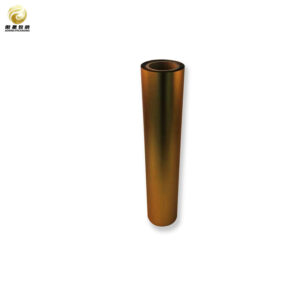Transparent Polypropylene Roll
| Product | Transparent OPP Film |
| Material | OPP+ color+ aluminum layer / OPP + aluminum + color layer |
| Thickness | 15um; 18um |
| Color Option | Red,Blue,Purple,Green,Gold,Yellow,Rose,Rainbow,etc. |
| Width & Length | Width:500~1800mm Length:Customized |
Detailed Descriptions
Product Description: Transparent Polypropylene Roll
Introducing our premium Transparent Polypropylene Roll, a versatile and high-performance packaging solution designed to meet the diverse needs of various industries. Crafted from high-quality polypropylene, this roll offers exceptional clarity and durability, making it an ideal choice for both commercial and industrial applications.
Key Features:
1. Exceptional Clarity: Our Transparent Polypropylene Roll boasts outstanding transparency, allowing for clear visibility of packaged products. This feature is particularly beneficial for retail environments where product presentation is crucial.
2. Durability and Strength: Engineered to withstand the rigors of handling and transportation, this polypropylene roll exhibits remarkable tensile strength. It resists tearing and puncturing, ensuring that your products remain securely packaged throughout their journey.
3. Lightweight Yet Sturdy: Despite its lightweight nature, the roll provides robust protection against environmental factors such as moisture and dust. This makes it an excellent choice for packaging food items, electronics, textiles, and more.
4. Versatile Applications: The Transparent Polypropylene Roll is suitable for a wide range of applications including wrapping, bundling, and protecting products. It can be used in various sectors such as retail, manufacturing, logistics, and food service.
5. Eco-Friendly Option: Our polypropylene material is recyclable, making it an environmentally responsible choice for businesses looking to reduce their carbon footprint while maintaining high packaging standards.
6. Easy to Use: The roll format allows for convenient dispensing and cutting to desired lengths, streamlining your packaging process. Whether you are using manual or automated systems, our polypropylene roll integrates seamlessly into your operations.
7. Customizable Sizes: Available in various widths and thicknesses, our Transparent Polypropylene Roll can be tailored to meet specific requirements. This flexibility ensures that you can find the perfect fit for your unique packaging needs.
Applications:
– Retail Packaging: Ideal for showcasing products while providing protection. – Food Packaging: Safe for direct contact with food items; perfect for deli meats, baked goods, and more. – Industrial Use: Suitable for bundling components or protecting machinery during storage or transport. – Crafting Projects: A favorite among crafters for creating custom gift wraps or decorative displays.
Conclusion:
As an established exporter in the industry, we understand the importance of competitive pricing. That’s why we offer bulk buy options at wholesale rates, allowing you to maximize your savings while ensuring you have an ample supply of this essential material. Our bulk price offerings are designed to cater to businesses of all sizes, from small enterprises to large corporations.
We also provide OEM services tailored to your specific requirements, enabling you to customize the dimensions and specifications of the Transparent Polypropylene Roll according to your unique needs. This flexibility ensures that you receive a product that perfectly aligns with your operational demands.
Partnering with us means choosing a reliable producer who is dedicated to fostering long-term relationships with our clients. Our commitment to quality, efficiency, and customer satisfaction sets us apart in the competitive landscape of packaging solutions.
In summary, our Transparent Polypropylene Roll is not just a product; it’s a strategic investment for your business. With our extensive experience as a manufacturer and supplier in China, we are well-equipped to support your packaging needs with exceptional service and quality assurance. Contact us today to explore bulk buy opportunities and discover how our transparent polypropylene solutions can elevate your business operations.







